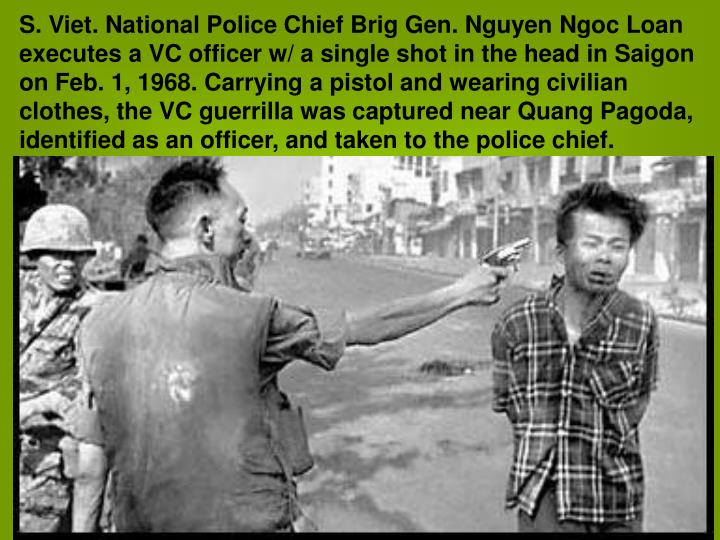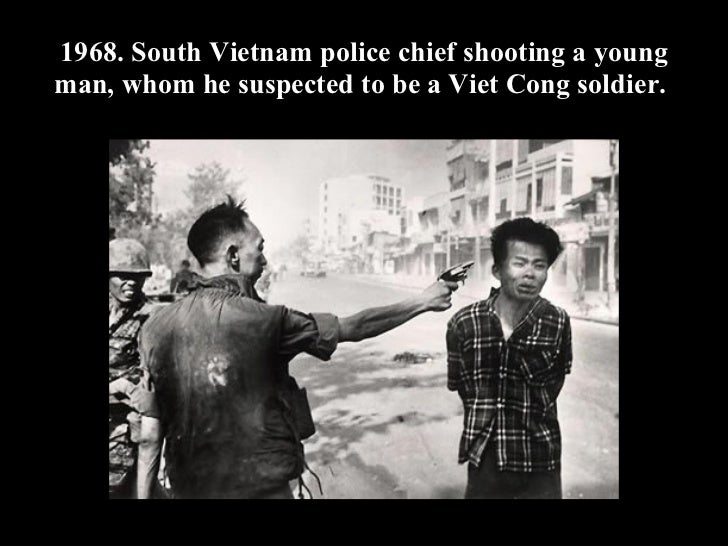

The shooting was barely a blip in Loan’s schedule. The man just pulled a pistol out of his holster, raised it to the VC’s head and shot him in the temple.

So I prepared to make that picture – the threat, the interrogation. It was common to hold a pistol to the head of prisoners during questioning. He took a pistol out of his holster and raised it. I saw a man walk into my camera viewfinder from the left. When they were close – maybe five feet away – the soldiers stopped and backed away. “…followed the three of them as they walked towards us, making an occasional picture. Photographer Eddie Adams was out looking for interesting things to capture that day, and he saw what he thought was an ordinary Viet Cong soldier being dragged out into the street. The “Saigon Execution” photo that would become an icon of the anti-war movement in the West was caught largely by accident. He wasn’t wearing a uniform, he wasn’t fighting a battle, and he had evidently committed a major war crime against General Loan’s own subordinates and their kids.Īs a war criminal and terrorist, Lém had effectively no protection under the Geneva Conventions and was eligible for summary execution when caught. On the morning of the “Saigon Execution” photo, Nguyễn Văn Lém’s death squad had just killed 34 people – seven police officers, two or three Americans, and several police officers’ family members, all bound at the wrists and shot in the head over a pit – and they may have been looking for Loan himself. The man being shot in the “Saigon Execution” photo was Nguyễn Văn Lém, also known as Captain Bay Lop, and he was exactly the kind of enemy fighter that Loan’s men were looking for.Īccording to Lém’s widow, he had disappeared just prior to the Tet Offensive, and according to the soldiers who captured him in Saigon, he was caught practically red-handed leading a Viet Cong hit team tasked with killing National Police members or, if they couldn’t find any, their families instead. On the morning of the “Saigon Execution” photo, Loan was leading a police detachment in Saigon looking for at-risk civilians and the Viet Cong who might be a threat to them. He also hated communism with a passion, and he routinely blocked the release of Viet Cong prisoners and secret negotiations that threatened to cut the South out of a peace deal.

Many times, Loan had intervened to restrict the violence of American combat operations in the Mekong Delta, and he was among the strongest voices in Saigon for asserting South Vietnam’s sovereignty in its dealings with the United States. Universally adored by his men, he had led combat operations against the North, both on land and as a pilot, and he had risen to the rank of Brigadier General on merit, rather than by the nepotism common in the Saigon government.įrom the war’s earliest days, Loan’s loyalty to his government had marked him as a potential troublemaker even for the Americans, who resented his interference in their operations. The first thing to know about General Loan is that he was absurdly good at his job. General Loan, as commander of South Vietnam’s National Police Force, was part of the effort to retake the city. It was clear that the guerrillas had a lot of logistical support from areas thought to be loyal to the South, and that everything the brass had been saying about progress toward victory was false.Įarly in the attack, Saigon itself was overrun, which gave the Viet Cong the opportunity to cleanse the city of political enemies and settle some old scores. The Tet Offensive of early 1968 blew those lies out of the water.Īll at once, 80,000 communist troops struck more than 100 targets all over the country. From about 1964, however, the Lyndon Johnson administration had maintained the line that resistance was diminishing and that the whole country should be pacified soon. The latter operated in the shadows from villages all over South Vietnam, and American intelligence was all but incapable of gauging its strength and locations. For several years, what began as a limited advisory deployment had grown into full-scale combat between US forces and a volatile mix of North Vietnamese regular forces and Viet Cong guerrillas. By 1968, America was as deep as it was going to get in the war in Vietnam.


 0 kommentar(er)
0 kommentar(er)
